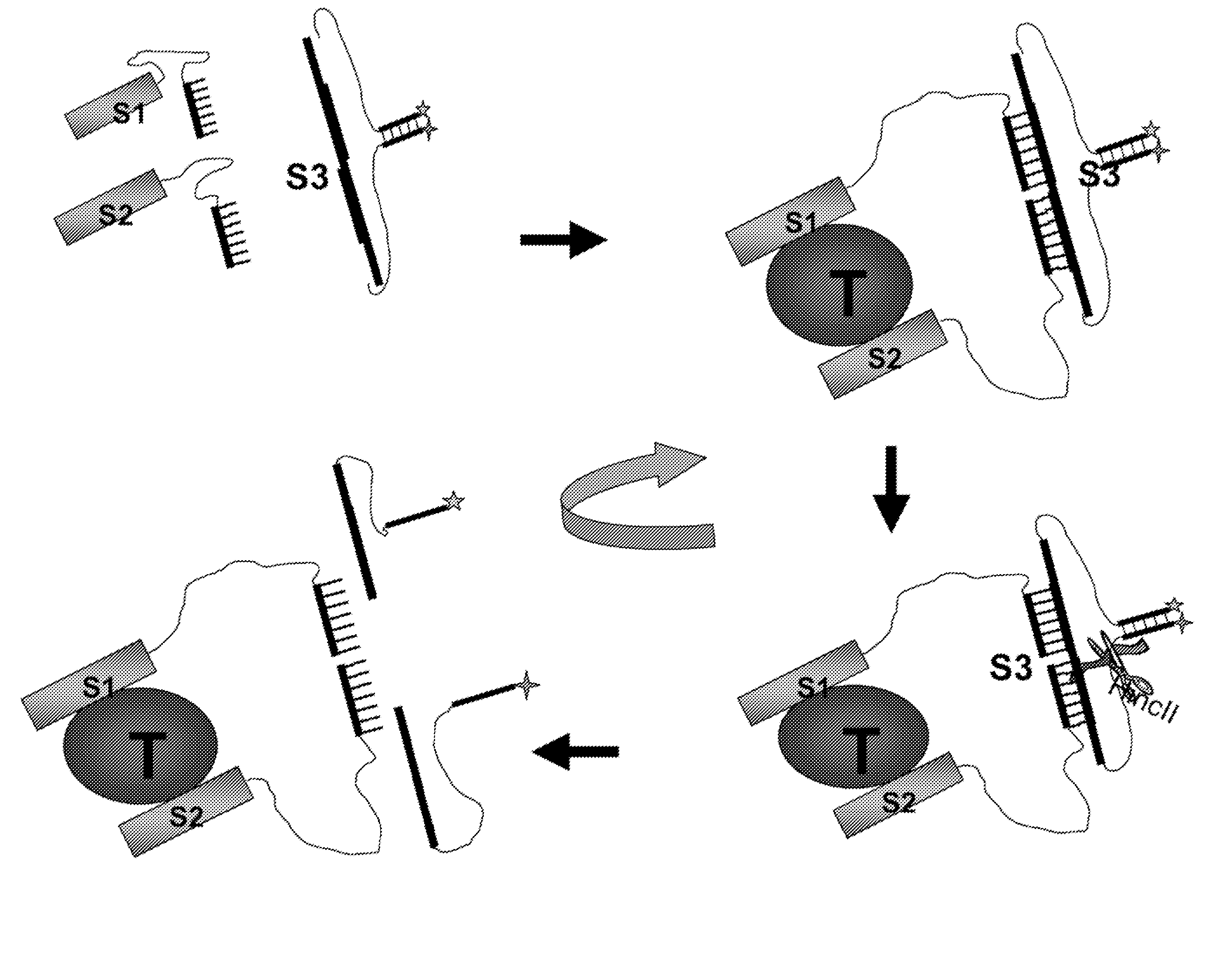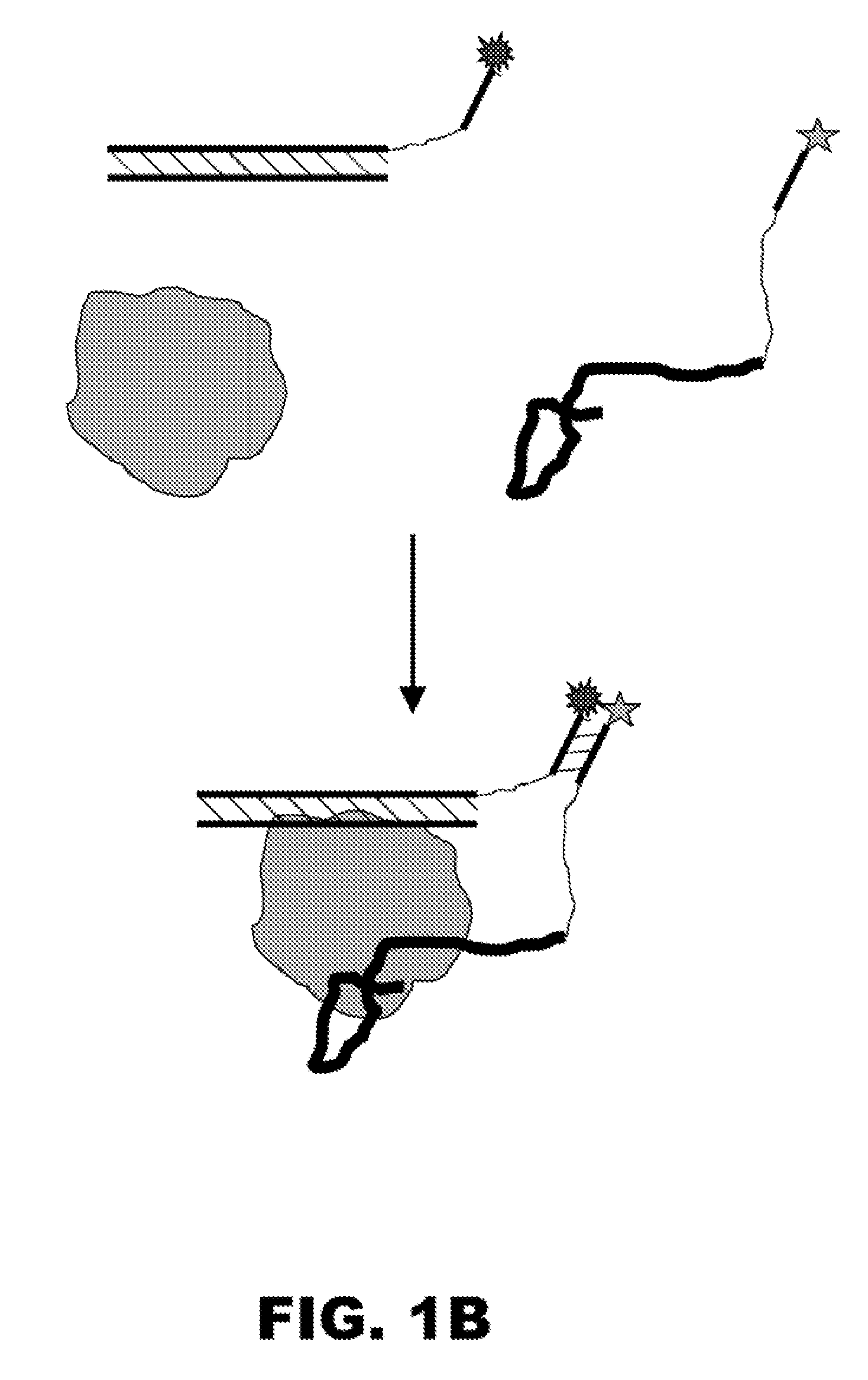Three-component biosensors for detecting macromolecules and other analytes
a biosensor and macromolecule technology, applied in the field of three-component molecular biosensors, can solve the problems of inability to rapidly and parallelly detect high-throughput protein detection, inability to detect specific molecules in our environment, and inability to adapt to rapid and high-throughput parallel protein detection
- Summary
- Abstract
- Description
- Claims
- Application Information
AI Technical Summary
Benefits of technology
Problems solved by technology
Method used
Image
Examples
example 1
General Method for Preparing Specific Aptamer Constructs
Introduction
[0284] Disclosed is a method for the rapid and sensitive detection of proteins, protein complexes, or analytes that bind to proteins. This method is based on the protein-driven association of two constructs containing aptamers that recognize two distinct epitopes of a protein (a.k.a. “aptamer constructs”) (FIG. 1A). These two aptamer constructs contain short complementary signaling oligonucleotides attached to the aptamers through a flexible linker. Upon the simultaneous binding of the two aptamers to the target protein, the complementary oligonucleotides (a.k.a. “signaling oligos”) are brought into relative proximity that promotes their association to form a stable duplex. Attaching fluorescence probes to the ends of the signaling oligos provides a means of detecting the protein-induced association of the two aptamers constructs (FIG. 1A). In the case of proteins that possess natural nucleic acid binding activit...
example 2
Methods and Aptamers for Detecting Thrombin
Introduction
[0294] The inventors of the instant invention have developed a methodology for detecting DNA binding proteins, as described in Heyduk, T. and Heyduk, E. “Molecular beacons for detecting DNA binding proteins,” Nature Biotechnology, 20,171-176, 2002, Heyduk, E., Knoll, E., and Heyduk, T. “Molecular beacons for detecting DNA binding proteins: mechanism of action,” Analyt. Biochem. 316, 1-10, 2003, and copending patent applications No. 09 / 928,385, which issued as U.S. Pat. No. 6,544,746, Ser. No. 10 / 062,064, PCT / US02 / 24822 and PCT / US03 / 02157, all of which are incorporated herein by reference. This methodology is based on splitting the DNA binding site for a protein into two DNA “half-sites” (FIG. 3A). Each of the resulting “half-sites” contains a short complementary single-stranded region of the length designed to introduce some propensity for the two DNA “half-sites” to associate recreating the duplex containing the fully functi...
example 3
Analyte Detection in a Sample
Materials
[0311] Purified thrombin was a gift from Dr. Ray Rezaie (St. Louis University). Factor Xa, prothrombin, ovalbumin, bovine serum albumin, single-stranded binding protein, trypsin and plasma were purchased from Sigma (St. Louis, Mo.). HeLa cellular extracts were from ProteinOne (College Park, Md.). Texas Red-NHS and Sybr Green were from Molecular Probes (Eugene, Oreg.), Cy5-NHS and Cy3-NHS were from Amersham Biosciences (Piscataway, N.J.), and AMCA-sulfoNHS was from Pierce (Rockford, Ill.). All other reagents were commercially available analytical grade.
[0312] Oligonucleotide constructs used throughout this work are listed in Table 1. Oligonucleotides were obtained from Keck Oligonucleotide Synthesis Facility at Yale University or from IDT (Coralville, Iowa). 5′ fluorescein and 3′ dabcyl were incorporated using appropriate phosphoramidates during oligonucleotide synthesis. All other fluorophores were incorporated into oligonucleotides by post-...
PUM
| Property | Measurement | Unit |
|---|---|---|
| Temperature | aaaaa | aaaaa |
| Temperature | aaaaa | aaaaa |
| Molar density | aaaaa | aaaaa |
Abstract
Description
Claims
Application Information
 Login to View More
Login to View More - R&D
- Intellectual Property
- Life Sciences
- Materials
- Tech Scout
- Unparalleled Data Quality
- Higher Quality Content
- 60% Fewer Hallucinations
Browse by: Latest US Patents, China's latest patents, Technical Efficacy Thesaurus, Application Domain, Technology Topic, Popular Technical Reports.
© 2025 PatSnap. All rights reserved.Legal|Privacy policy|Modern Slavery Act Transparency Statement|Sitemap|About US| Contact US: help@patsnap.com



